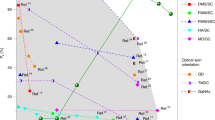Abstract
The field of magnetoelectronics has been growing in practical importance in recent years1. For example, devices that harness electronic spin—such as giant-magnetoresistive sensors and magnetoresistive memory cells—are now appearing on the market2. In contrast, magnetoelectronic devices based on spin-polarized transport in semiconductors are at a much earlier stage of development, largely because of the lack of an efficient means of injecting spin-polarized charge. Much work has focused on the use of ferromagnetic metallic contacts3,4, but it has proved exceedingly difficult to demonstrate polarized spin injection. More recently, two groups5,6 have reported successful spin injection from an NiFe contact, but the observed effects of the spin-polarized transport were quite small (resistance changes of less than 1%). Here we describe a different approach, in which the magnetic semiconductor BexMnyZn1-x-ySe is used as a spin aligner. We achieve injection efficiencies of 90% spin-polarized current into a non-magnetic semiconductor device. The device used in this case is a GaAs/AlGaAs light-emitting diode, and spin polarization is confirmed by the circular polarization state of the emitted light.
This is a preview of subscription content, access via your institution
Access options
Subscribe to this journal
Receive 51 print issues and online access
$199.00 per year
only $3.90 per issue
Buy this article
- Purchase on Springer Link
- Instant access to full article PDF
Prices may be subject to local taxes which are calculated during checkout




Similar content being viewed by others
References
Simmonds,J. L. Magnetoelectronics today and tomorrow. Phys. Today 48(4), 26–32 (1995).
Parkin,S. S. P. et al. Exchange-biased magnetic tunnel junctions and application to nonvolatile magnetic random access memory. J. Appl. Phys. 85, 5828–5833 (1999).
Datta,S. & Das,B. Electronic analog of the electro-optic modulator. Appl. Phys. Lett. 56(7), 665–667 (1990).
Prinz,G. A. Spin-polarized transport. Phys. Today 48(4), 58–63 (1995).
Hammar,P. R., Bennet,B. R., Yang,M. J. & Johnson,M. Observation of spin injection at a ferromagnet-semiconductor interface. Phys. Rev. Lett. 83(1), 203–206 (1999).
Gardelis,S., Smith,C. G., Barnes,C. H. W., Linfield,E. H. & Ritchie,D. A. Spin-value effects in a semiconductor field effect transistor: A spintronic device. Phys. Rev. B 60(11), 7764–7767 (1999).
Matsukura,F., Ohno,H., Shen,A. & Sugawara Y. Transport properties and origin of ferromagnetism in (Ga,Mn)As. Phys. Rev. B 57, R2037–R2040 (1998).
Furdyna,J. K. Diluted magnetic semiconductors. J. Appl. Phys. 64, R29–R64 (1988).
Moodera,J. S., Meservey,R. & Hao,X. Variation of the electron-spin polarization in EuSe tunnel junctions from zero to near 100% in a magnetic field. Phys. Rev. Lett. 70(6), 853–856 (1993).
Oestreich,M. et al. Spin injection into semiconductors. Appl. Phys. Lett. 74, 1251–1253 (1999).
Carlos Egues J. Spin-dependent perpendicular magnetotransport through a tunable ZnSe/Zn1-xMnxSe heterostructure: A possible spin filter. Phys. Rev. Lett. 80(20), 4578–4581 (1998).
Hägele,D., Oestreich,M., Rühle,W. W., Nestle,N. & Eberl,K. Spin transport in GaAs. Appl . Phys. Lett. 73(1), 1580–1582 (1998).
Kikkawa,J. M. & Awschalom,D. D Lateral drag of spin coherence in gallium arsenide. Nature 397, 139–141 (1999).
Aronov,A. G. & Pikus,G. E. Spin injection into semiconductors. Sov. Phys. Semicond. 10, 698–700 (1976).
Weisbuch,C. & Vinter,B. Quantum Semiconductor Structures—Fundamentals and Applications (Academic, Boston, 1991).
Awschalom,D. D. & Kikkawa,J. M. Electron spin and optical coherence in semiconductors. Phys. Today 6, 33–38 (1999).
Acknowledgements
We acknowledge the financial support of the European Commission (Esprit project SPIDER) as well as the Bundesministerium für Bildung und Forschung (Verbundprojekt Elektronische Korrelationen und Magnetismus). We would also like to thank Th. Gruber, V. Hock, B. König, D.Yakovlev, G. Müller and G. E. W. Bauer for discussions and help.
Author information
Authors and Affiliations
Corresponding author
Rights and permissions
About this article
Cite this article
Fiederling, R., Keim, M., Reuscher, G. et al. Injection and detection of a spin-polarized current in a light-emitting diode. Nature 402, 787–790 (1999). https://doi.org/10.1038/45502
Received:
Accepted:
Issue Date:
DOI: https://doi.org/10.1038/45502
This article is cited by
-
Controlling the helicity of light by electrical magnetization switching
Nature (2024)
-
Room-temperature spin injection from a ferromagnetic semiconductor
Scientific Reports (2023)
-
Experimental studies of Cr2NiAl half-metallic inverse Heusler compound for spintronic applications
Journal of Materials Science: Materials in Electronics (2023)
-
Recent developments in CVD growth and applications of 2D transition metal dichalcogenides
Frontiers of Physics (2023)
-
Precise Detection, Control and Synthesis of Chiral Compounds at Single-Molecule Resolution
Nano-Micro Letters (2023)
Comments
By submitting a comment you agree to abide by our Terms and Community Guidelines. If you find something abusive or that does not comply with our terms or guidelines please flag it as inappropriate.



